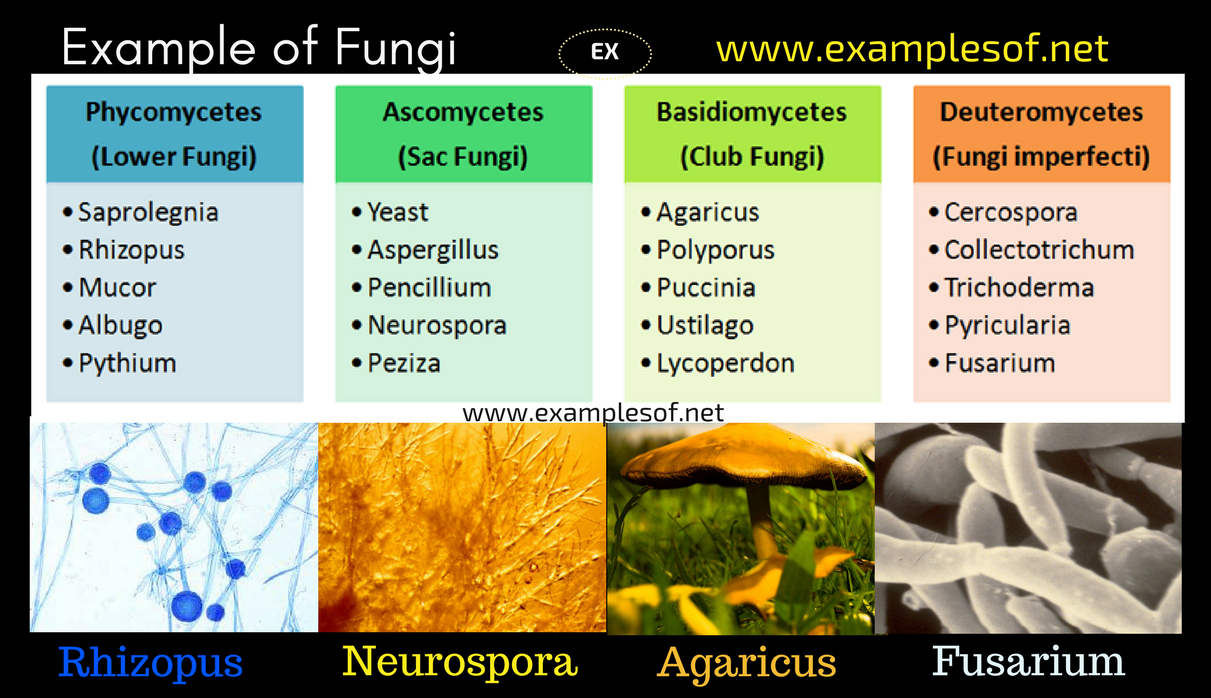Fungi, a kingdom distinct from plants and animals, constitute an essential sect of biodiversity, rendering fecund contributions to ecosystems and human societies alike. This discourse delves into the intricate classification of fungi, unraveling the intriguing typologies and providing eminent examples encapsulating their vast diversity. Understanding the taxonomy of fungi not only augments our biological knowledge but also facilitates advancements in fields like medicine, agriculture, and environmental science.
The classification of fungi is predominantly based on reproductive structures, genetic data, and life cycles. Mycologists have established a systematic taxonomy encapsulating various divisions and phyla, most notably the following: Zygomycetes, Ascomycetes, Basidiomycetes, and Glomeromycetes. Each division presents unique characteristics and reproduces via distinct strategies, reflecting the evolutionary adaptations of these organisms.
Fungi exhibit a myriad of forms and functions, and their classification scheme is multifaceted, embracing criteria ranging from morphological features to molecular phylogenetics. This multi-dimensional approach to classification elucidates the rich evolutionary narratives embedded in the fungal realm.
Let us embark on a comprehensive exploration of the primary divisions of fungi, outlining their salient attributes, reproductive mechanisms, and representative species.
The Zygomycetes Phylum: Molding a Substrate for Diversity
Zygomycetes represents one of the most rudimentary divisions within the fungal kingdom. This group is characterized by the formation of zygospores during sexual reproduction, which occur through the fusion of specialized hyphae. Typically found in terrestrial habitats, these fungi often inhabit moist environments and are instrumental in the decomposition of organic matter.
Key features of Zygomycetes include:
- Hyphal Structure: Generally coenocytic, meaning their hyphae are aseptate, leading to multinucleated filaments.
- Reproductive Strategies: They reproduce asexually through sporangiospores, and their sexual reproduction via zygospores occurs when environmental conditions become unfavorable.
- Ecological Role: This group contains numerous saprophytic fungi that contribute to soil health and nutrient cycling.
Prominent examples of Zygomycetes include Rhizopus stolonifer, commonly known as black bread mold, and Mucor species, which are often found in decaying organic materials. The implications of these fungi extend beyond mere decomposition; some zygomycetes have gained attention for their potential in biotechnological applications, including enzyme production and bioremediation processes.
The Ascocycetes Phylum: Ascending the Ladder of Complexity
Ascocycetes, or Ascomycetes, is the largest and most diverse phylum within the fungal domain. Ascomycetes are distinguished by their unique production of ascospores through sac-like structures known as asci. Occupying various ecological niches, these fungi range from unicellular yeasts to complex multicellular forms.
Key characteristics of Ascomycetes include:
- Ascus Formation: The hallmark of this group is the ascus, wherein they produce ascospores, culminating in intricate reproductive cycles that can be sexual or asexual.
- Highlighting Diversity: This phylum encompasses diverse representatives, including yeasts, molds, and morels, showcasing a wide range of morphological forms.
- Significance in Industry: Many Ascomycetes play pivotal roles in food production (such as Aspergillus oryzae in fermentation) and pharmaceuticals (notably Penicillium chrysogenum for penicillin extraction).
Remarkable examples include the yeast Saccharomyces cerevisiae, a cornerstone organism in both baking and brewing, and the morel mushroom Morchella esculenta, highly regarded in culinary applications. These fungi not only illustrate the fascinating evolutionary pathways of Ascomycetes but also highlight their practical significance across multiple domains.
The Basidiomycetes Phylum: The Majestic Fruiting Bodies
Basidiomycetes epitomize fungal grandeur, widely recognized for their elaborate fruiting bodies known as basidiocarps. This group encompasses a plethora of familiar mushrooms, bracket fungi, and rusts, showcasing a remarkable capacity for complex life histories and symbiotic relationships.
Defining attributes of Basidiomycetes include:
- Basidium Formation: Distinguished by the basidium structure, they produce basidiospores, contributing to their extensive reproductive versatility.
- Ecological Interactions: Many Basidiomycetes engage in significant ecological roles, forming mycorrhizal partnerships with plants, thus enhancing nutrient uptake.
- Diversity in Edibility: This phylum includes both edible and toxic species, providing crucial resources for sustenance while also carrying inherent risks.
Exemplary representatives of Basidiomycetes include the edible mushroom Agaricus bisporus, commonly known as the button mushroom, and the infamous Amanita muscaria, recognized for its striking appearance and hallucinogenic properties. The deep ecological relationships facilitated by this phylum extend to agricultural practices, where mycorrhizal fungi enhance crop yield and resilience.
The Glomeromycetes Phylum: Grounding Our Ecosystems
Glomeromycetes manifest a relatively lesser-known yet pivotal tapestry within the fungal kingdom, primarily recognized for their formation of arbuscular mycorrhizal fungi (AMF). These organisms create intricate symbiotic relationships with approximately 80% of terrestrial plants, establishing a foundation for nutrient exchange that is vital for ecosystem health.
Characteristics defining Glomeromycetes include:
- Arbuscular Mycorrhizae: The formation of structures known as arbuscules within plant roots enables efficient nutrient transfer, emphasizing their symbiotic importance.
- Reproductive Mechanisms: A primarily asexual life cycle complicates traditional classification yet underscores the adaptive strategies of these fungi.
- Ecological Resonance: Their presence significantly influences soil structure, fertility, and microbial diversity, illustrating a crucial ecological niche.
Noteworthy examples of Glomeromycetes include species from the genus Glomus, which are instrumental in enhancing plant growth and resilience through improved nutrient absorption. Understanding the dynamics of Glomeromycetes is essential for sustainable agricultural practices, particularly as global food security faces mounting challenges.
In summation, the classification of fungi reveals a world of complexity and diversity, each phylum contributing uniquely to biological systems and human endeavors. From the decomposition champions in Zygomycetes to the culinary marvels of Ascomycetes, the mycological kingdom deserves recognition as a cornerstone of ecological and economic functionality. Grasping the nuances of fungal classification not only facilitates scholarly discourse but also amplifies appreciation for these remarkable organisms and their multifarious roles in our biosphere.
The exploration of fungi is an invitation to embrace the hidden intricacies of life, shedding light on evolutionary adaptations that have persisted through millennia. Continued research and taxonomy refinement are essential to unlock the full potential of fungi, ensuring their contributions are celebrated and conserved for generations to come.
